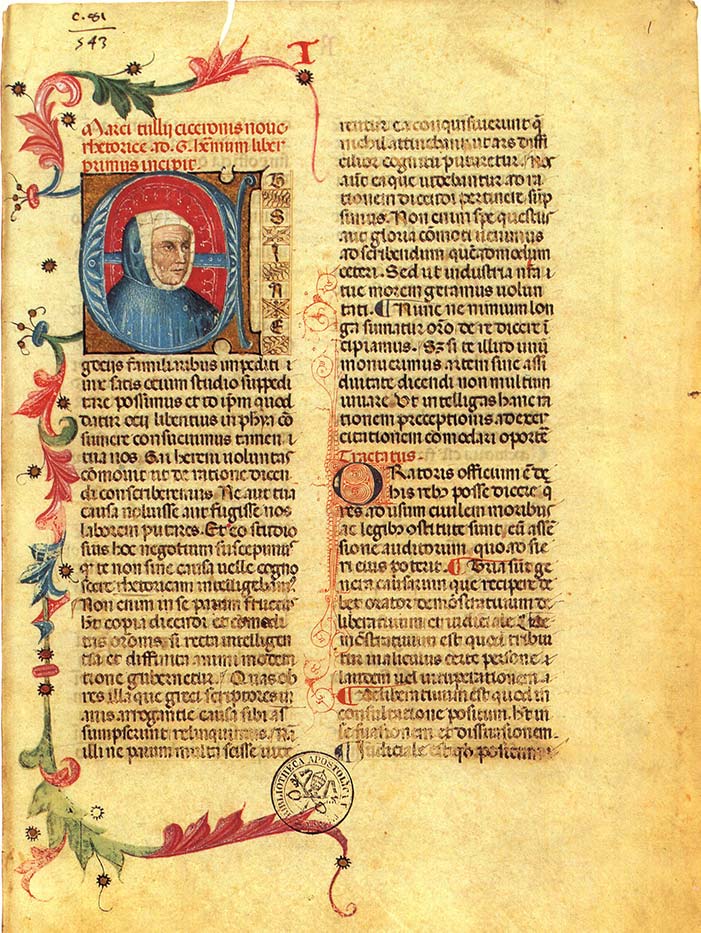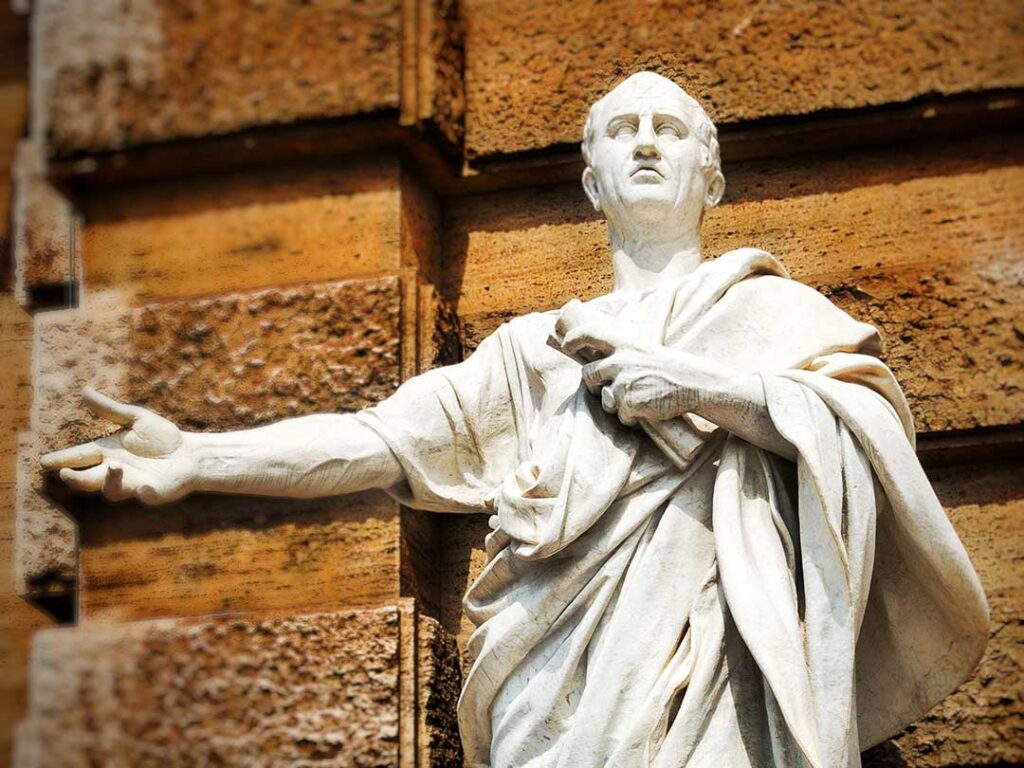Contents
Two thousand years of Latin Prose is a digital anthology of Latin Prose. Here you will be able to find texts from two millennia of gems in Latin. In this fourth chapter, we will learn about the rhetorical manual long thought to be the work of Cicero, called Ad Herennium. We will read a passage from book 3 (28–30) about memory – a very important ingredient for any orator.
If you want to learn more about the anthology, you will find the preface here.
Ad Herennium: An Introduction
(c. 86–82 B.C.)
Ad Herennium, or Rhetorica Ad Herennium, or De ratione dicendi ad C. Herennium, is the oldest rhetorical treatise in Latin and one of the most studied books in European history.

This book, this treatise or rhetorical manual, was probably written sometime between 86 and 82 B.C. and has no known author, nor a known original title. It has been called a version of Ad Herennium or Rhetorica ad Herennium, as it is dedicated to one Gaius Herennius. Who this Gaius Herennius was, we do not know.
The art of rhetoric became increasingly popular and important in the ancient world and from the 5th century, B.C. onwards schools appeared where rhetoric was taught. This led to the collection of information, expertise, and experiences in the form of textbooks. An early example of this is Aristoteles’ (384–322 B.C.) Rhetoric.
For books in Latin about rhetoric, Ad Herennium is the oldest one known. Apart from Ad Herennium, we can also find examples in Latin literature such as Cicero’s De inventione and De oratore, and Quintilian’s Institutio Oratoria.
We don’t know if Ad Herennium was popular during antiquity, we don’t even know if it was ever used by the Romans. However, it became one of the most influential works on rhetoric further on in history.
When we stepped into the Christian era of European history, Ad Herennium popped up like a jack-in-the-box and was recommended by the early Christian Church Fathers. One of the reasons for the recommendations was that from at least Hieronymus’ time (known to many as Saint Jerome) i.e. c. 347–420 A.D., it was believed that Rhetorica Ad Herennium was a work of Cicero.

Today, this hypothesis has been scrapped, but Cicero was a contemporary of the unknown writer of Ad Herennium and he was one of, if not the, greatest orator Rome had seen. Cicero was also considered a so-called “virtuous pagan” by the Early Christian Church, deeming his works worthy of preservation and study despite him having been a pagan.
The high esteem and authoritative awe in which Cicero was held, rubbed off on Ad Herennium which in combination with its format—it is a rather short book, very clear, systematic, and pedagogic—turned it into one of the most important textbooks of Western European history.
It became a standard textbook for teaching rhetoric in schools from the Carolingian era to the Renaissance and was usually used alongside Cicero’s De Inventione. But even long after the Renaissance, Ad Herennium, was important – used still as a textbook, a reference, or a model when you wrote new books on the subject.
The work itself is, as mentioned, clear and pedagogically written. It goes through different kinds of speeches, as well the mechanics of giving a speech, e.g. voice, emotion, and body language, how to handle the language, be eloquent and create a varied and expressive style, but also how to remember your speech.
The book is crammed with examples, which are many times wonderfully written. Take this one from liber 4 for example where the likeness of an untamed horse is used to illustrate virtue:
“Neque equus indomitus, quamvis bene natura conpositus sit, idoneus potest esse ad eas utilitates quae desiderantur ab equo; neque homo indoctus, quamvis sit ingeniosus, ad virtutem potest pervenire.”
— Ad Herennium, 4.59
“Neither can an untrained horse, however well-built by nature, be fit for the services desired of a horse, nor can an uncultivated man, however well-endowed by nature, attain to virtue.” (transl. Harry Caplan)

What set Ad Herennium apart from other rhetorical works was that it covers all sides of rhetoric. Many times you would only learn about rhetoric in theory from a rhetorical textbook, but Ad Herennium also gave you the practical side of rhetoric. How to actually hold a speech. The completeness of the manual with theory and practice hand in hand is what made it so popular for schools and teachers of the subject. It was the perfect handbook on how to hold a speech. A “rhetoric 101”, so to speak.
In today’s chapter of 2000 years of Latin Prose, we will turn to book 3.28–30 and a passage of Ad Herennium that is the oldest surviving treatment in Latin of this specific subject. A subject that is always relevant, and where the old techniques described in Ad Herennium are still – after over 2000 years – being used successfully, and not just in the rhetorical sphere. I’m talking about the so important memory and mnemonic techniques.
Further reading
I highly recommend that you join the great number of people who throughout history have read and studied Ad Herennium, and read this gem from cover to cover. If not in Latin, read it in English or find a translation to your preferred language. You can find it in Latin with a parallel English translation here.
If you want to know more about Cicero, long thought to have written Ad Herennium, check out Chapter 5 of 2000 Years of Latin Prose.
Latin audio and video
Click below to read and listen to a passage from Ad Herennium.
Video with English subtitles
Audio recording of the Latin text
Latin Text
Below you will find the original text of the passage in Latin.
Ad Herennium, 3.28–30
Nunc ad thesaurum inventorum atque ad omnium partium rhetoricae custodem, memoriam, transeamus.
Memoria utrum habeat quiddam artificiosi, an omnis ab natura proficiscatur, aliud dicendi tempus magis idoneum dabitur. Nunc proinde atque constet in hac re multum valere artem et praeceptionem, ita de ea re loquemur. Placet enim nobis esse artificium memoriae—quare placeat alias ostendemus; in praesentia cuiusmodi sit ea aperiemus.
Sunt igitur duae memoriae: una naturalis, altera artificiosa. Naturalis est ea quae nostris animis insita est et simul cum cogitatione nata; artificiosa est ea quam confirmat inductio quaedam et ratio praeceptionis. Sed qua via in ceteris rebus ingenii bonitas imitatur saepe doctrinam, ars porro naturae commoda confirmat et auget, item fit in hac re ut nonnumquam naturalis memoria, si cui data est egregia, similis sit huic artificiosae, porro haec artificiosa naturae commoda retineat et amplificet ratione doctrinae. Quapropter et naturalis memoria praeceptione confirmanda est ut sit egregia, et haec quae doctrina datur indiget ingenii. Nec hoc magis aut minus in hac re quam in ceteris artibus fit, ut ingenio doctrina, praeceptione natura nitescat. Quare et illis qui natura memores sunt utilis haec erit institutio, quod tute paulo post poteris intellegere; et si illi, freti ingenio, nostri non indigerent, tamen iusta causa daretur quare iis qui minus ingenii habent adiumento velimus esse. Nunc de artificiosa memoria loquemur.
Constat igitur artificiosa memoria ex locis et imaginibus. Locos appellamus eos qui breviter, perfecte, insignite aut natura aut manu sunt absoluti, ut eos facile naturali memoria conprehendere et amplecti queamus: ut aedes, intercolumnium, angulum, fornicem, et alia quae his similia sunt. Imagines sunt formae quaedam et notae et simulacra eius rei quam meminisse volumus; quod genus equi, leonis, aquilae memoriam si volemus habere, imagines eorum locis certis conlocare oportebit.
Vocabulary & Commentary
Below you will find some keywords and comments on the text.
These following words are key to understanding the text, if you already know them — great! — if not, make a mental note of them.
ab natura proficiscatur: whether it comes from nature
proinde atque constet: just as if it were established that…. Constat with the accusative and infitive often has the meaning of “it is established, accepted, agreed upon”.
placet: here it seems proper, I am of the opion that…
alias: adv. at another time
in praesentia: at present, for the time being
cuiusmodi: of what sort, what it is like
naturae commoda: the advantages of nature, i.e. gifts accorded someone by nature
item: similarly
nostri indiget: requires, needs us, i.e. the precepts of the author of Ad Herennium.
quapropter: therefore
loci et imagines: locations. In the realm of mnemonics, locations are the real or imagined places where one places images (imagines) that refer to the information one wants to memorize. I will treat the art of memory at length in an upcoming article.
paulo post: shortly after, shortly
intercolumnium, ‑i, n. the space between two columns. Inter in compound nouns indicates the space between two things, e.g. interregnum, the time between the end of one king’s rule and the beginning of another’s.
quod genus: here for example. Cf. another example of this expression from Ad Herennium: Quod genus, si dicam me ex provincia rediisse, profectum quoque in provicniam intellegatur (“For example, if I were to say that I have returned from the province, it would be understood that I had also gone there”.)
English Translation
Below you will find an English translation of the text.
Ad Herennium, 3.28–30
Now let me turn to the treasure-house of the ideas supplied by Invention, to the guardian of all the parts of rhetoric, the Memory.
The question whether memory has some artificial quality, or comes entirely from nature, we shall have another, more favourable, opportunity to discuss. At present I shall accept as proved that in this matter art and method are of great importance, and shall treat the subject accordingly. For my part, I am satisfied that there is an art of memory—the grounds of my belief I shall explain elsewhere. For the present I shall disclose what sort of thing memory is.
There are, then, two kinds of memory: one natural, and the other the product of art. The natural memory is that memory which is imbedded in our minds, born simultaneously with thought. The artificial memory is that memory which is strengthened by a kind of training and system of discipline. But just as in everything else the merit of natural excellence often rivals acquired learning, and art, in its turn, reinforces and develops the natural advantages, so does it happen in this instance. The natural memory, if a person is endowed with an exceptional one, is often like this artificial memory, and this artificial memory, in its turn, retains and develops the natural advantages by a method of discipline. Thus the natural memory must be strengthened by discipline so as to become exceptional, and, on the other hand, this memory provided by discipline requires natural ability. It is neither more nor less true in this instance than in the other arts that science thrives by the aid of innate ability, and nature by the aid of the rules of art. The training here offered will therefore also be useful to those who by nature have a good memory, as you will yourself soon come to understand. But even if these, relying on their natural talent, did not need our help, we should still be justified in wishing to aid the less well-endowed. Now I shall discuss the artificial memory.
The artificial memory includes locations and images. By locations I mean such scenes as are naturally or artificially set off on a small scale, complete and conspicuous, so that we can grasp and embrace them easily by the natural memory—for example, a house, an intercolumnar space, a recess, an arch, or the like. An image is, as it were, a figure, mark, or portrait of the object we wish to remember; for example, if we wish to recall a horse, a lion, or an eagle, we must place its image in a definite location.
Translated by Harry Caplan, (1954)
















